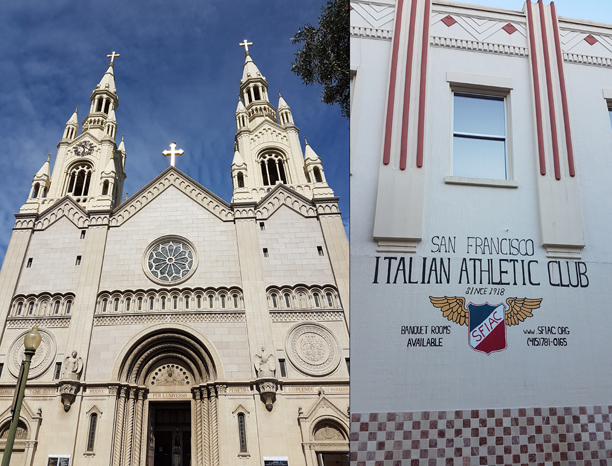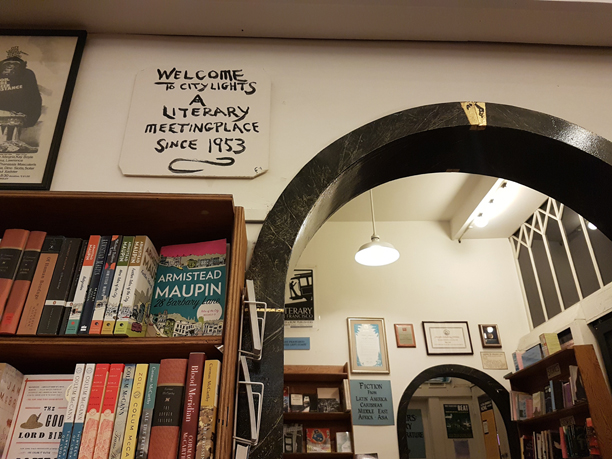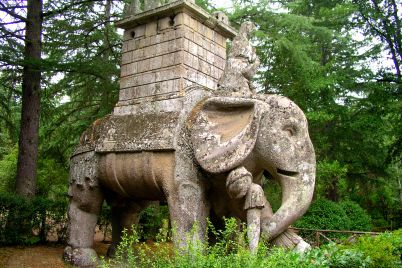It is impossible to think of San Francisco without its Italian heritage. There are the notables: A.P. Giannini, who founded the Bank of America; filmmaker and vintner, Francis Ford Coppola; baseball’s Joe DiMaggio, once married Marilyn Monroe; and Joseph Alioto, San Francisco’s legendary mayor. The Italian Heritage Parade, dating back to 1868, is San Francisco’s oldest civic event, and the oldest Italian-American parade in the United States.
Then there are the neighbourhoods: North Beach and Fisherman’s Wharf are on every visitor’s map. Both were home to Italians who settled in San Francisco, some as early as the 1840s. Add Telegraph Hill and you have what is known as Little Italy. Although many families eventually moved to neighbourhoods with larger homes, North Beach remains resolutely Italian, with restaurants, cafes, bakeries, and the graceful St. Peter and St. Paul Church flanking the grassy Washington Square. Down Columbus Avenue is City Lights, one of North America’s most admired bookstores. Owner and poet Lawrence Ferlinghetti, now in his late 90s, was the first to publish the poetry of Allen Ginsberg, and the black and white City Lights editions are still sold at City Lights.
Many of North America’s major cities have a Little Italy. But San Francisco is different, notes Italian Cultural Institute Director, Paolo Barlera. Sitting in the Institute’s new building, near the city’s Beaux Arts City Hall and ornate opera house, Barlera explains that the first wave of immigrants came from Northern Italy – Liguria, Lucca, Genoa, north of Tuscany. “They were demographically different from the Southern Italians who would later settle in the US East Coast,” he says. At that time, people identified as Ligurian, Lombardian or Sicilian. (Even immigration statistics listed people by their regional affiliation.)

This surprising history is detailed in a virtual exhibit at the University of California Berkeley’s Bancroft Library. It notes that at one point, northern Italians fought with Sicilians for control of Telegraph Hill. The second wave of immigrants from Italy came in the late 1940s. The ideal was to integrate, Barlera explains, and many of their children did not learn Italian. “Yet you can still hear Italian spoken in North Beach.” I certainly did, at Molinari and Sons Delicatessan, a North Beach landmark for shoppers. In addition to selling all manner of olive oil, wine, salads and cured meats, Molinari’s makes mouth-watering sandwiches. Now that they have chairs outside, you can eat them in situ.

Fisherman’s Wharf was settled by Italian fishermen, including the Alioto brothers, from a village west of Palermo. Alioto’s restaurant, the first in Fisherman’s Wharf, started as a fish shack, where Rose Alioto cooked for fishermen. It grew into a two-story restaurant with a great view of the Bay. Rose’s cioppino, a fish stew, became a signature San Francisco dish. And 92 years later, in the elegant Alioto’s restaurant, cioppino is what I order. It comes with tender pieces of crab, prawns, mussels and clams, in a fragrant tomato sauce accented with garlic and parsley. I am having lunch with Annette Alioto, part of the family’s third generation that now runs the business. Joseph Alioto, the legendary mayor, was a second cousin.

“In my adult life it was a no-brainer where I was going to work,” says Annette, adding, “I could offer my children the same.” Her brother Mario, a lawyer, is the president of the company.Tradition lives on in Fisherman’s Wharf and in North beach. On the corner of Columbus and Vallejo Streets is Caffe Trieste, still owned by the Giotta family, claims to be the first espresso bar in California. It has been the hangout for poets and other artists for over sixty years. Francis Ford Coppola wrote much of the screenplay for The Godfather here.

The elegant North Beach Restaurant, started by a Tuscan chef, is upscale and old school, with Florentine floor tiles and Venetian granite. Italian-speaking waiters in tuxes lead you to your table. You can count on regulars dining on risotto, veal, lamb and vegetables. On the lower level, the ceiling is hung with what seems like a forest of prosciutto – the restaurant cures its own.

When it comes to the Italian presence in the San Francisco Bay area, there is a surprising new chapter. “The last five years has seen a new wave of educated Italians moving to San Francisco and Silicon Valley,” notes ICI director, Paolo Barlera. These biomedical researchers, architects and dot com entrepreneurs have not blended in with the established Italian community, he adds. “Yet these new immigrants have more interest in nurturing their Italian culture than I have seen in the U.S.,” says Barlera, whose former post was in New York City. They have established networks, and have injected energy to the events like the annual Italian Film Festival that takes place in November. Also, notes Barlera, they need schools for their children and want them to keep the Italian language. The recent opening of La Scuola Internazionale attracts an increasing number of non-Italian children.
And if there was any doubt about the continuing Italian presence in San Francisco, Angela Alioto, a well-known attorney and former Supervisor, and daughter of mayor Joseph Alioto, officially declared last December that she would be running for mayor.
Photos by Jacqueline Swartz.
Jacqueline Swartz has published articles on travel, health and other topics in most major Canadian publications, as well as in Conde Nast Traveller, the Boston Globe and the Chicago Tribune. She has visited no-go places in India, covered politics in Greece and published a three-part series on popular philosophy in France. A native San Franciscan, she now lives in Toronto.



